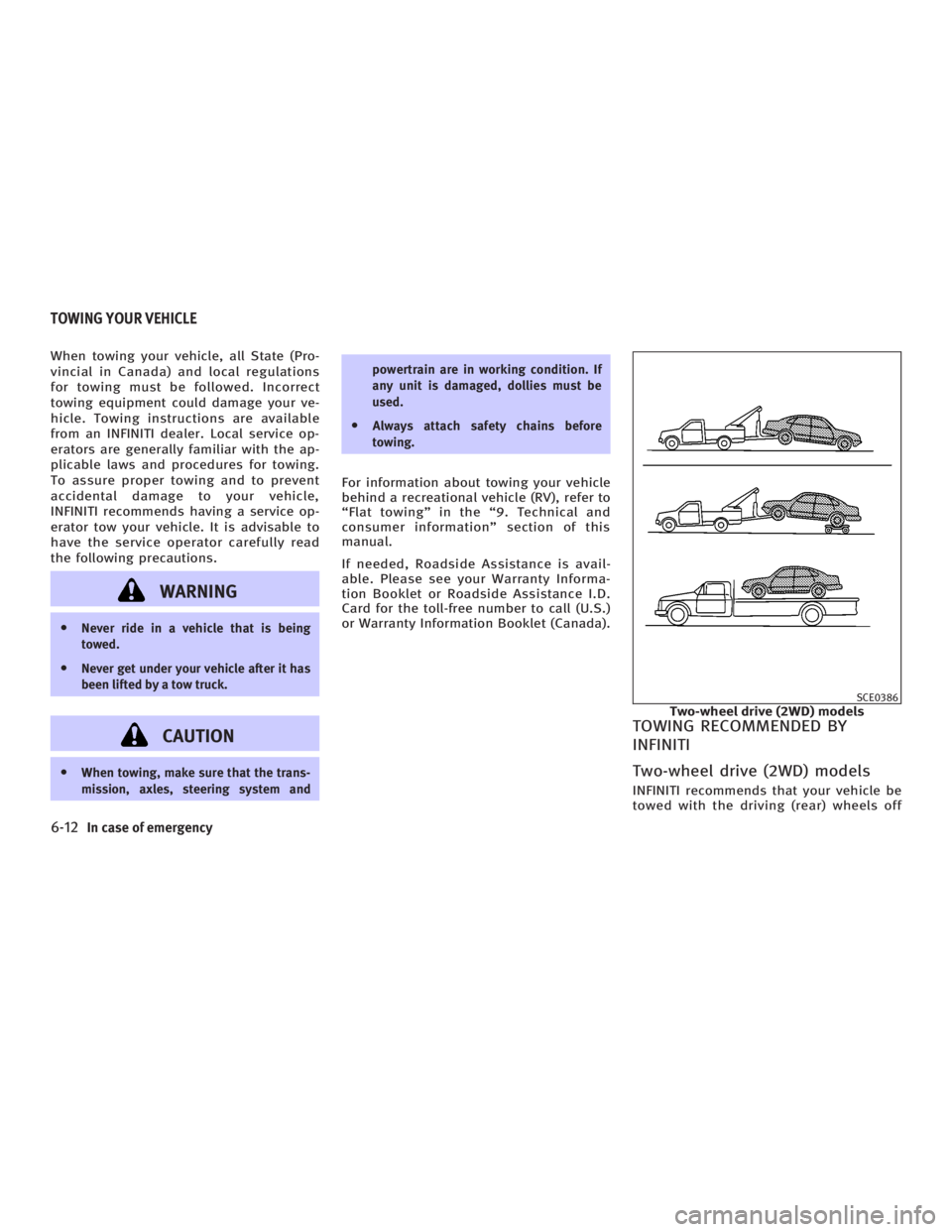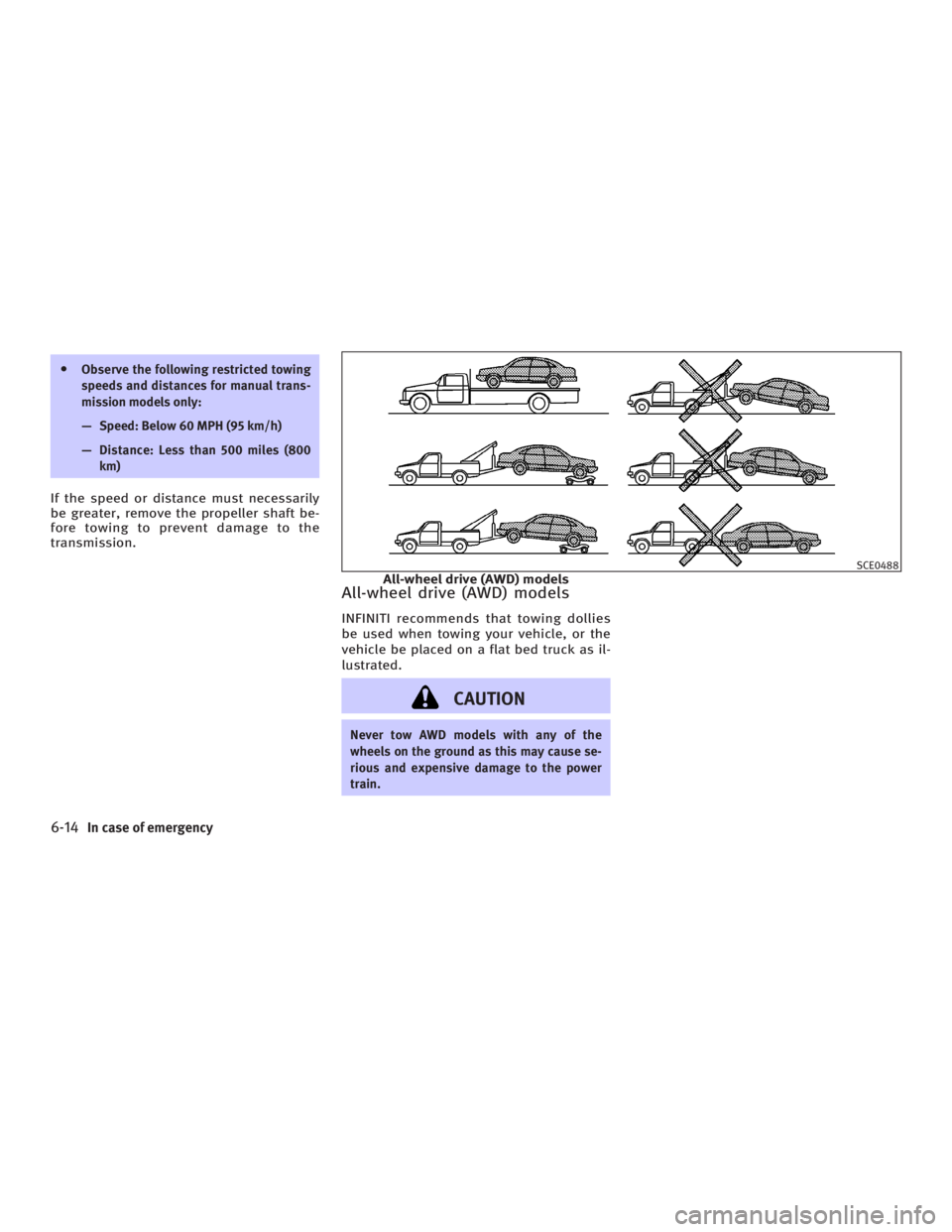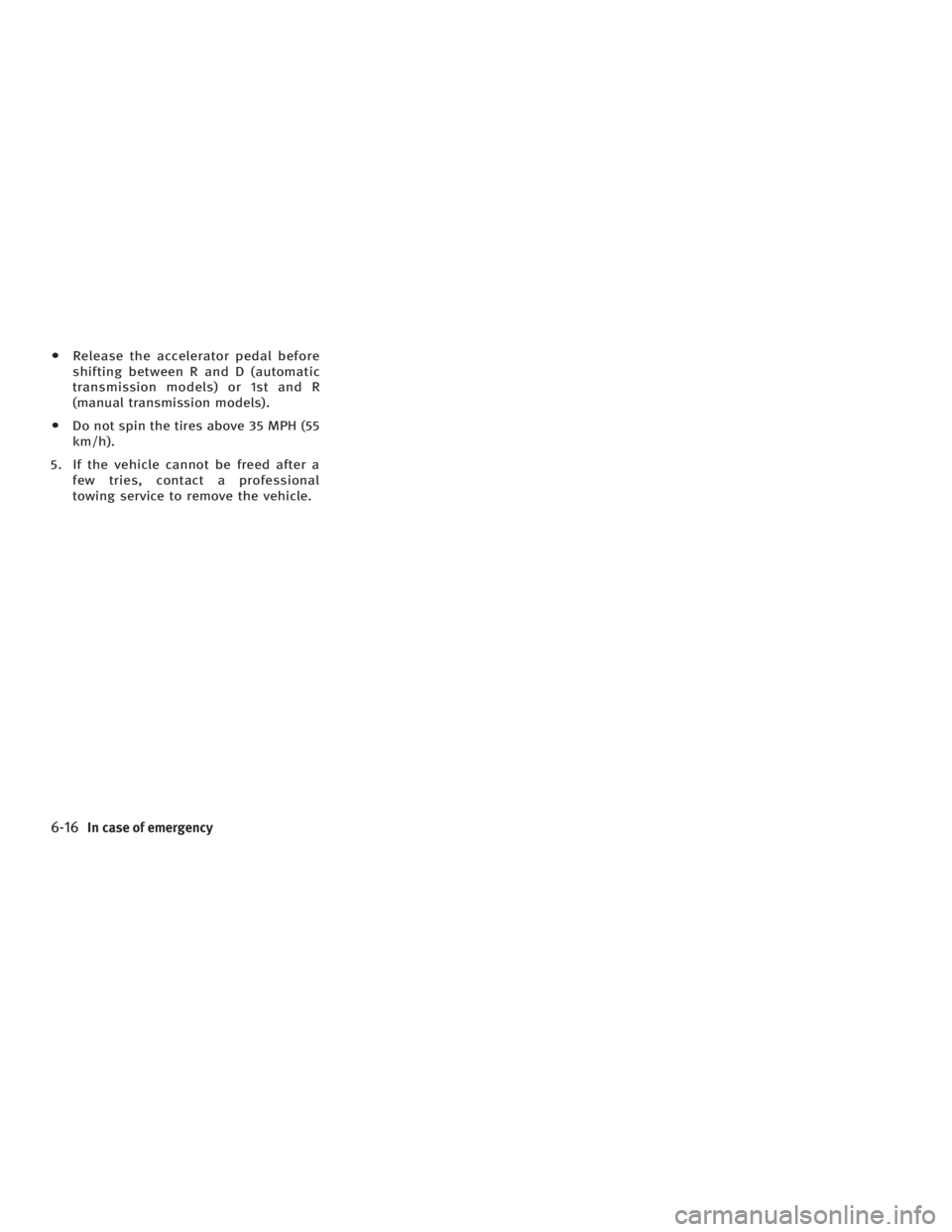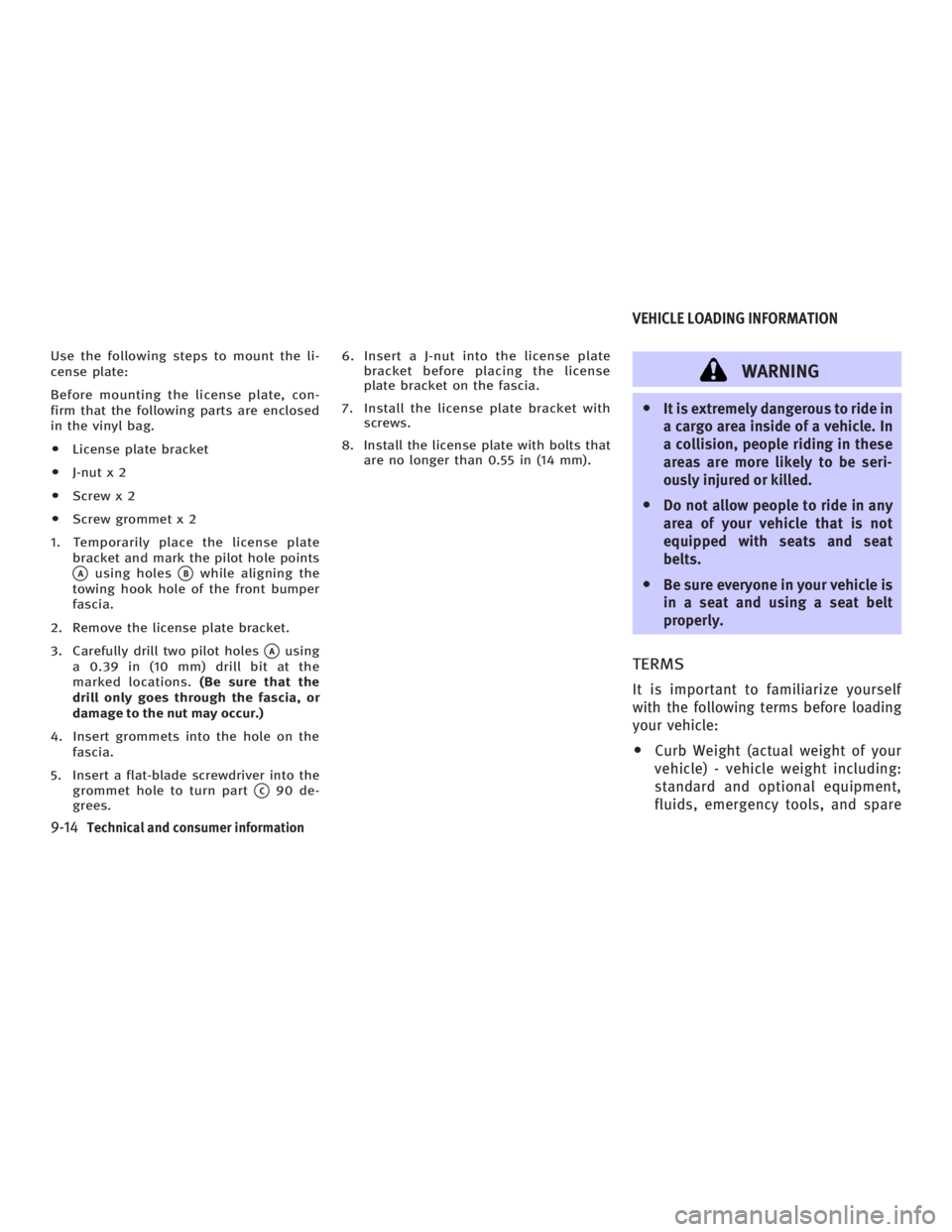2006 INFINITI G35 emergency towing
[x] Cancel search: emergency towingPage 237 of 344

6 In case of emergency Roadside assistance program ........................... 6-2
Flat tire ............................................................ 6-2
Tire pressure monitoring system (TPMS) .... 6-2
Changing a flat tire ..................................... 6-2
Jump starting ................................................... 6-8
Push starting .................................................. 6-10 If your vehicle overheats ................................. 6-11
Towing your vehicle ........................................ 6-12
Towing recommended by INFINITI .............. 6-12
Vehicle recovery (Freeing a stuck
vehicle) ...................................................... 6-15
w 06.1.4/V35-D/V5.0
X
Page 248 of 344

When towing your vehicle, all State (Pro-
vincial in Canada) and local regulations
for towing must be followed. Incorrect
towing equipment could damage your ve-
hicle. Towing instructions are available
from an INFINITI dealer. Local service op-
erators are generally familiar with the ap-
plicable laws and procedures for towing.
To assure proper towing and to prevent
accidental damage to your vehicle,
INFINITI recommends having a service op-
erator tow your vehicle. It is advisable to
have the service operator carefully read
the following precautions.
WARNINGO Never ride in a vehicle that is being
towed.
O Never get under your vehicle after it has
been lifted by a tow truck.
CAUTIONO When towing, make sure that the trans-
mission, axles, steering system and powertrain are in working condition. If
any unit is damaged, dollies must be
used.
O Always attach safety chains before
towing.
For information about towing your vehicle
behind a recreational vehicle (RV), refer to
ªFlat towingº in the ª9. Technical and
consumer informationº section of this
manual.
If needed, Roadside Assistance is avail-
able. Please see your Warranty Informa-
tion Booklet or Roadside Assistance I.D.
Card for the toll-free number to call (U.S.)
or Warranty Information Booklet (Canada).
TOWING RECOMMENDED BY
INFINITI
Two-wheel drive (2WD) models INFINITI recommends that your vehicle be
towed with the driving (rear) wheels off SCE0386
Two-wheel drive (2WD) modelsTOWING YOUR VEHICLE
6-12 In case of emergency
w 06.1.4/V35-D/V5.0
X
Page 249 of 344

the ground or place the vehicle on a flat
bed truck as illustrated.
CAUTION O Never tow automatic transmission
models with the rear wheels on the ground or four wheels on the ground
(forward or backward) as this may cause
serious and expensive damage to the
transmission. If it is necessary to tow the
vehicle with the front wheels raised, al-
ways use towing dollies under the rear
wheels.
O When towing rear wheel drive models
with the front wheels on the ground or
on towing dollies:
Turn the ignition key to the OFF position,
and secure the steering wheel in a
straight ahead position with a rope or
similar device. Never secure the steering
wheel by turning the ignition key to the
LOCK position. This may damage the
steering lock mechanism.
O If you have to tow manual transmission
models with the rear wheels on the
ground or four wheels on the ground (if
you do not use towing dollies):
O Always release the parking brake.
O Move the transmission shift lever to
the N (Neutral) position. SCE0387A
Automatic transmission (AT) models
In case of emergency
6-13
w 06.1.4/V35-D/V5.0
X
Page 250 of 344

O Observe the following restricted towing
speeds and distances for manual trans-
mission models only:
Ð Speed: Below 60 MPH (95 km/h)
Ð Distance: Less than 500 miles (800
km)
If the speed or distance must necessarily
be greater, remove the propeller shaft be-
fore towing to prevent damage to the
transmission.
All-wheel drive (AWD) models INFINITI recommends that towing dollies
be used when towing your vehicle, or the
vehicle be placed on a flat bed truck as il-
lustrated.
CAUTION Never tow AWD models with any of the
wheels on the ground as this may cause se-
rious and expensive damage to the power
train. SCE0488
All-wheel drive (AWD) models
6-14 In case of emergency
w 06.1.4/V35-D/V5.0
X
Page 251 of 344

VEHICLE RECOVERY (Freeing a
stuck vehicle) After removing the front license plate (or
the bumper cover), securely install the re-
covery hook
q 1
. (Located with jacking
tools.)
Reinstall the license plate on the lower fit-
ting point. WARNING O Stand clear of a stuck vehicle.
O Do not spin your tires at high speed. This
could cause them to explode and result
in serious injury. Parts of your vehicle
could also overheat and be damaged.
CAUTION O Tow chains or cables must be attached
only to the vehicle recovery hooks or
main structural members of the vehicle.
Otherwise, the vehicle body will be dam-
aged.
O Do not use the vehicle tie downs to free a
vehicle stuck in sand, snow, mud, etc.
Never tow a vehicle using the vehicle tie
downs or recovery hooks.
O Always pull the cable straight out from
the front of the vehicle. Never pull the ve-
hicle at an angle. O Pulling devices should be routed so they
do not touch any part of the suspension,
steering, brake or cooling systems.
O Pulling devices such as ropes or canvas
straps are not recommended for use in
vehicle towing or recovery.
If your vehicle is stuck in sand, snow,
mud, etc., use the following procedure:
1. Turn off the Vehicle Dynamic Control
(VDC) system.
2. Make sure the area in front and be-
hind the vehicle is clear of obstruc-
tions.
3. Turn the steering wheel right and left
to clear an area around the front tires.
4. Slowly rock the vehicle forward and
backward.
O Shift back and forth between R (re-
verse) and D (drive) (automatic trans-
mission models) or 1st (low) and R (re-
verse) (manual transmission models).
O Apply the accelerator as little as pos-
sible to maintain the rocking motion.SCE0524
In case of emergency
6-15
w 06.1.4/V35-D/V5.0
X
Page 252 of 344

O Release the accelerator pedal before
shifting between R and D (automatic
transmission models) or 1st and R
(manual transmission models).
O Do not spin the tires above 35 MPH (55
km/h).
5. If the vehicle cannot be freed after a
few tries, contact a professional
towing service to remove the vehicle.
6-16 In case of emergency
w 06.1.4/V35-D/V5.0
X
Page 320 of 344

Use the following steps to mount the li-
cense plate:
Before mounting the license plate, con-
firm that the following parts are enclosed
in the vinyl bag.
O License plate bracket
O J-nut x 2
O Screw x 2
O Screw grommet x 2
1. Temporarily place the license plate
bracket and mark the pilot hole points
q A
using holes
q B
while aligning the
towing hook hole of the front bumper
fascia.
2. Remove the license plate bracket.
3. Carefully drill two pilot holes
q A
using
a 0.39 in (10 mm) drill bit at the
marked locations. (Be sure that the
drill only goes through the fascia, or
damage to the nut may occur.)
4. Insert grommets into the hole on the
fascia.
5. Insert a flat-blade screwdriver into the
grommet hole to turn part
q C
90 de-
grees. 6. Insert a J-nut into the license plate
bracket before placing the license
plate bracket on the fascia.
7. Install the license plate bracket with
screws.
8. Install the license plate with bolts that
are no longer than 0.55 in (14 mm).
WARNING O It is extremely dangerous to ride in
a cargo area inside of a vehicle. In
a collision, people riding in these
areas are more likely to be seri-
ously injured or killed.
O Do not allow people to ride in any
area of your vehicle that is not
equipped with seats and seat
belts.
O Be sure everyone in your vehicle is
in a seat and using a seat belt
properly.
TERMS It is important to familiarize yourself
with the following terms before loading
your vehicle:
O Curb Weight (actual weight of your
vehicle) - vehicle weight including:
standard and optional equipment,
fluids, emergency tools, and spare VEHICLE LOADING INFORMATION
9-14 Technical and consumer information
w 06.1.4/V35-D/V5.0
X
Page 329 of 344

O For emergency towing procedures refer
to ªTowing recommended by INFINITIº in
the ª6. In case of emergencyº section of
this manual.
Automatic transmission To tow a vehicle equipped with an auto-
matic transmission, an appropriate ve-
hicle dolly MUST be placed under the
towed vehicle's drive wheels. Always
follow the dolly manufacturer's recom-
mendations when using their product.
Manual transmission O Always tow with the manual transmis-
sion in Neutral.
O After towing 500 miles, start and idle
the engine with the transmission in
Neutral for two minutes. Failure to idle
the engine after every 500 miles of
towing may cause damage to the
transmission's internal parts. DOT (Department Of Transportation) Qual-
ity Grades: All passenger car tires must
conform to federal safety requirements in
addition to these grades.
Quality grades can be found where appli-
cable on the tire sidewall between tread
shoulder and maximum section width. For
example:
Treadwear 200 Traction AA Temperature A
Treadwear The treadwear grade is a comparative rat-
ing based on the wear rate of the tire
when tested under controlled conditions
on a specified government test course.
For example, a tire graded 150 would wear
one and one-half (1 1/2) times as well on
the government course as a tire graded
100. The relative performance of tires de-
pends upon the actual conditions of their
use, however, and may depart signifi-
cantly from the norm due to variations in
driving habits, service practices and dif-
ferences in road characteristics and cli-
mate.
Traction AA, A, B and C The traction grades, from highest to
lowest, are AA, A, B, and C. Those grades represent the tire's ability to stop on wet
pavement as measured under controlled
conditions on specified government test
surfaces of asphalt and concrete. A tire
marked C may have poor traction perfor-
mance.
WARNING The traction grade assigned to this tire is
based on straight-ahead braking traction
tests, and does not include acceleration, cor-
nering, hydroplaning, or peak traction char-
acteristics.
Temperature A, B and C The temperature grades A (the highest),
B, and C, representing the tire's resis-
tance to the generation of heat and its
ability to dissipate heat when tested
under controlled conditions on a specified
indoor laboratory test wheel. Sustained
high temperature can cause the material
of the tire to degenerate and reduce tire
life, and excessive temperature can lead
to sudden tire failure. The grade C corre-
sponds to a level of performance which
all passenger car tires must meet under
the Federal Motor Safety Standard No.UNIFORM TIRE QUALITY GRADING
Technical and consumer information
9-23
w 06.1.5/V35-D/V5.0
X